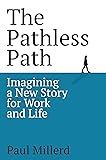Highlights from "The Pathless Path"
By Paul Millerd

put your head down and keep going, indefinitely. This is what I call the “default path.”
The pathless path is an alternative to the default path. It is an embrace of uncertainty and discomfort. It’s a call to adventure in a world that tells us to conform.
You have the perfect life on paper, but no time to enjoy it. You retire with millions in the bank, but no idea what to do with your time.
was in the wrong rooms, asking the wrong questions about how to live.
This limits the ideas of what we see as possible and many, including me, internalize the “worldly wisdom” that John Maynard Keynes once pointed out, “that it is better for reputation to fail conventionally than to succeed unconventionally.”
“I don’t know anyone who has done that.” Many people fall into this trap.
The pathless path has helped me see that quitting my job was never about escaping work or living an easier life, it was about using the gifts I received from my parents to benefit others.
This is the trap of prestigious career paths. Instead of thinking about what you want to do with your life, you default to the options most admired by your peers.
When I was sick, I would have traded every last credential for a single day of feeling okay.
In Weber’s view, a “traditionalist” view of work is one where people work as much as they need to maintain their current lifestyle, and once that aim is achieved, they stop working.
It might surprise you that in Greece, during the time of Aristotle more than 2,000 years ago, work was simply considered a necessary evil.
Working hard in the area of one’s calling determines the status of a person’s relationship with God.
internalized the idea that I should be working all the time. Why have I internalized that idea? Because everything and everyone in my life has reinforced it – explicitly and implicitly – since I was young.”
“wage-based societies” where the central ethic was, “never mind what work you do, what counts is having a job.“
my head told me to list “career,” but my heart told me to list it last. This simple decision was my first conscious commitment to exploring the possibility of a life not centered around work.
“How do you design a life that doesn’t put work first?” The answer, my dear reader, is simple. You start underachieving at work.
“If work dominated your every moment, would life be worth living?”
Many people dislike some parts of their jobs. But they stay in their jobs because their suffering is familiar. To change would be to trade the known for the unknown and change brings discomfort in hard to predict forms.
Wonder is the state of being open to the world, its beauty, and potential possibilities. With wonder, the need to cope becomes less important and the discomfort on the current path becomes more noticeable.
Callard defines aspiration as the slow process of “trying on the values that we hope one day to possess.” This is in contrast to an ambitious journey where we already know what we value.
“If it is right, it happens—The main thing is not to hurry. Nothing good gets away.”
In Taiwan, I was able to embrace a state of doing nothing that was not filled with anxiety and tension, but reflective and open.
The spirit of the mini‑retirement is not about escaping work. It is about testing different circumstances to see if you want to double down on them or change directions.
I wish they knew what I know: the longer we spend on a path that isn’t ours, the longer it takes to move towards a path that is. Money might help pay for therapy, time off, and healing retreats, but it won’t help you come to a place where you really trust and know that everything will be okay.
The fact that the next steps are unknown to us is exactly the point.
Harvard professor Dr. Ben‑Shahar calls the arrival fallacy, the idea that when we reach a certain milestone we will reach a state of lasting happiness.
It’s knowing that I have enough friends that would gladly open their door and share a meal if I was ever in need.
Much of my previous life had been scripted into a routine and I spent almost all my time knowing where I was supposed to be. This short‑circuited my curiosity for years and kept me from seeing that there was a “conversation” with the world to be had at all.
On the pathless path, the goal is not to find a job, make money, build a business, or achieve any other metric. It’s to actively and consciously search for the work that you want to keep doing.
What does make sense is experimenting with different kinds of work, and once you find something worth doing, working backward to build a life around being able to keep doing it.
The need to feel useful is a powerful one. This is the hidden upside of the pathless path and a reason why finding work that aligns with what matters to you and makes you feel useful is so important.
I decided I would use the time to write. Then I realized that there was nothing stopping me from doing that at that moment. So I decided that instead of scaling my course, I would write this book.
a typical one or two-week vacation isn’t going to cut it. I believe that the minimum effective dose is at least a month away from work.